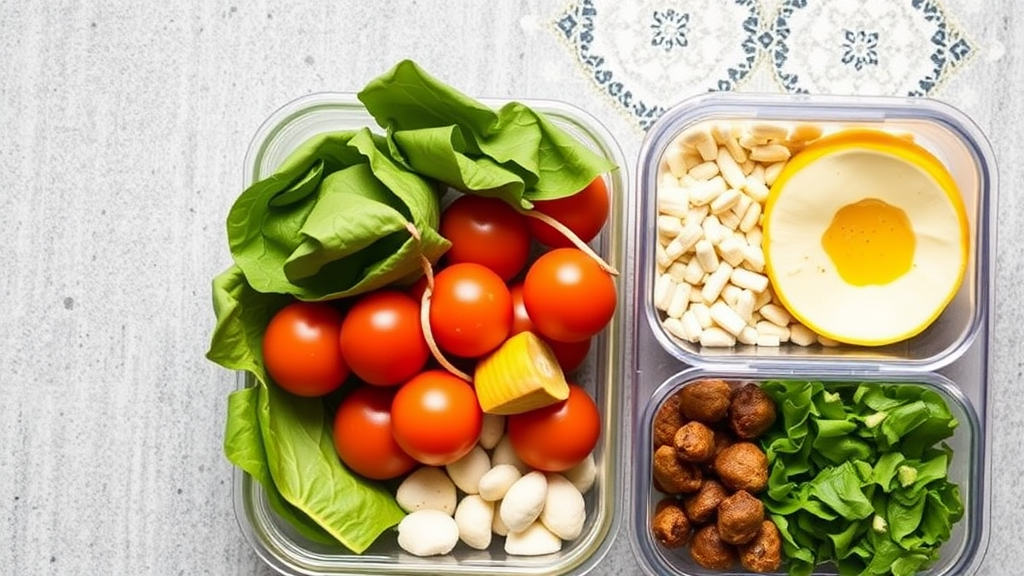Streamlining Meal Prepping for Effective Weight Loss
Meal prepping can be a game-changer on your journey to effective weight loss. The right strategies not only save time but also make it easier for you to stick to your fitness goals. Here’s how you can streamline your meal prepping process effortlessly.
Plan Your Meals Ahead of Time
Planning your meals is the first step toward successful meal prepping. Take some time each week to outline meals for breakfast, lunch, dinner, and snacks. A clear plan helps you avoid unhealthy food choices when hunger strikes. Here are a few tips to make planning seamless:
- Choose a day each week to set aside time for meal planning.
- Use a calendar or a meal planning app to organize your ideas.
- Consider trying themed days like Meatless Monday or Taco Thursday.
Make a Grocery List
Once your meals are planned, create a detailed grocery list. Sticking to a list helps prevent impulse buys and keeps your kitchen stocked with healthy ingredients. Here’s a simplified five-step process for making an effective list:
- Review your meal plan for the week.
- Check your pantry and fridge for existing items.
- Compile a list categorizing by sections: produce, protein, grains, etc.
- Stick to the perimeter of the grocery store where fresh items are typically located.
- Consider shopping at local farmers’ markets for fresh produce.
Batch Cooking Basics
Batch cooking is a fantastic way to prepare large quantities of healthy food at once. Here’s how to do this effectively:
- Start with one base ingredient, like chicken or quinoa, and build around it.
- Cook several servings of your favorite dishes, portion them into containers, and freeze what you won’t eat within the week.
- Utilize slow cookers or instant pots to make cooking easier and more efficient.
Invest in Quality Containers
Your meal prep containers are essential for success. Look for options that are:
- Microwave and dishwasher safe for easy reheating and cleaning.
- Leak-proof to protect your meals during transportation.
- Clear for visibility, so you can see what’s inside.
Prep Ingredients, Not Just Meals
Another effective strategy for meal prepping is preparing individual ingredients instead of complete meals. This approach offers flexibility throughout the week. Consider prepping:
- Chopped vegetables for easy salads and stir-fries.
- Cooked grains like rice or quinoa to use in various dishes.
- Protein options, such as grilled chicken or boiled eggs, that can be added to different meals.
Easy Snack Preparation
Healthy snacks can help you stay on track with your weight loss goals. When meal prepping, consider preparing healthy snacks in advance, such as:
- Veggie sticks with hummus.
- Greek yogurt with berries.
- Nuts and seeds in individual baggies.
By preparing snacks, you ensure you always have something healthy on hand, reducing the temptation to reach for unhealthy options.
Maximize Your Freezer Space
Freezing meals can help you preserve freshness and reduce waste. Here are some tips to maximize freezer storage:
- Use vacuum-sealed bags to save space and prevent freezer burn.
- Label each container with the meal type and date.
- Consider a “freezer inventory” to keep track of what’s stored away.
Stay Consistent
Consistency is key to making meal prepping a steady part of your routine. Set reminders on your phone for planning and prep times. Once you establish a rhythm, it will become second nature.
For more insights on meal prepping and weight loss, you might find these resources helpful:
- EatingWell – Meal Prep Tips (opens in a new window)
- Healthline – Meal Prepping for Weight Loss (opens in a new window)
With these strategies, meal prepping can become an easy and enjoyable part of your weight loss journey. Implement these tips to make your meal prepping not only easier but also more efficient for effective weight loss.
Essential Meal Prep Tools for Beginners
Starting your meal prep journey can feel overwhelming, but having the right tools makes all the difference. Investing in essential meal prep tools not only simplifies the process but also helps you stay organized and efficient in the kitchen. Below are some must-have items that will make your meal prepping easier and more enjoyable.
Cutting Tools
Every meal prepper needs quality cutting tools. Here are some essentials:
- Chef’s Knife: A good chef’s knife is versatile and allows you to chop, slice, and dice with precision.
- Cutting Board: Opt for a sturdy cutting board that can withstand daily use. Consider having separate boards for different types of food (meat, vegetables, etc.) to avoid cross-contamination.
- Food Processor: This tool can save you time by chopping vegetables, blending dips, or making purees quickly.
Measuring and Mixing Tools
Accurate measurements are crucial for healthy meal prep. Here are the measuring tools you should consider:
- Measuring Cups: Invest in a set of dry and liquid measuring cups for precise ingredient measurement.
- Measuring Spoons: Small measuring spoons are great for spices and smaller quantities.
- Mixing Bowls: Have multiple sizes on hand for mixing various ingredients. Look for stackable options to save space.
Storage Solutions
Proper food storage is key to keeping your meals fresh. Here are some storage solutions that work well:
- Glass Containers: Glass containers are durable, microwave-safe, and don’t retain odors. They come in various sizes, so you can find the perfect fit for each dish.
- Freezer Bags: These are perfect for batch cooking soups and stews. Freezer bags take up minimal space and can be easily labeled for clarity.
- Meal Prep Containers: Look for containers that offer compartments for different food types, helping portion control and keeping meals organized.
Cooking Appliances
These appliances can streamline your cooking process and enhance your meal prep efficiency:
- Slow Cooker: A slow cooker allows you to prepare entire meals with minimal effort. Just set it, and let it cook while you do other things.
- Instant Pot: This multi-cooker is perfect for quick meals. It can sauté, pressure cook, or steam, allowing for versatility in meal preparation.
- Blender: A blender is essential for smoothies, soups, and sauces. Consider a high-quality model that can handle ice and frozen ingredients.
Labeling Tools
When organizing your meals, labeling is vital. Here are some effective labeling tools:
- Label Maker: A label maker helps you create professional-looking labels for containers, making it easy to identify ingredients and prep dates.
- Dry-Erase Markers: If you use clear containers, dry-erase markers work wonders for quick labeling and can be easily wiped away.
Meal Prep Apps
Dive into the digital world of meal prepping with these apps:
- Mealime: This app allows you to create meal plans based on your preferences and dietary needs.
- Paprika Recipe Manager: This app helps store recipes, create shopping lists, and plan meals.
Having the right tools can make a significant difference in your meal prepping journey. Investing in quality items not only enhances your cooking experience but also helps you stick to your weight loss goals. By simplifying the cooking process, you can focus on enjoying healthy meals rather than feeling overwhelmed.
For more tips on meal prepping and healthy eating, consider checking out resources like Meal Prep on Fleek and The Kitchn.
Creating a Balanced Meal Plan: Recipes and Tips
Creating a balanced meal plan is an essential step in maintaining a healthy lifestyle. However, it can seem daunting at first. With the right approach and a few tried-and-true recipes, you can simplify the process while ensuring your diet is nutritious and satisfying. Below are some effective tips and recipes to help you design a balanced meal plan.
Understanding the Basics of a Balanced Meal
A balanced meal typically includes a variety of food groups that provide your body with necessary nutrients. Here’s a breakdown of what to include:
- Protein: Sources include lean meats, fish, eggs, beans, and legumes. Aim for a serving at every meal.
- Whole Grains: Choose quinoa, brown rice, or whole grain bread. They provide fiber and keep you full longer.
- Fruits and Vegetables: Strive for a colorful plate by including a variety of fruits and veggies. Aim for half your plate.
- Healthy Fats: Incorporate sources like avocados, nuts, seeds, and olive oil for heart health.
Easy Meal Prep Tips
Meal prepping can help you stick to your balanced meal plan. Here are some tips to make it easier:
- Plan Your Meals: Spend some time each week to map out your meals. Consider using a meal planning template to stay organized.
- Batch Cook: Prepare large quantities of grains, proteins, and roasted vegetables to use throughout the week.
- Use Versatile Ingredients: Choose ingredients that can be used in multiple recipes, which saves time and reduces waste.
- Pre-Get Ready Snacks: Cut up fruits and vegetables and store them for easy snacking.
Simple Balanced Meal Recipes
Here are a couple of easy, balanced meal recipes you can prepare. Each meal provides a healthy combination of protein, carbohydrates, and fats.
Quinoa and Black Bean Salad
This vibrant salad is packed with fiber and protein.
Ingredients:
- 1 cup quinoa, cooked
- 1 can black beans, drained and rinsed
- 1 cup cherry tomatoes, halved
- 1 bell pepper, diced
- ¼ cup red onion, chopped
- 2 tablespoons olive oil
- Juice of 1 lime
- Salt and pepper to taste
Instructions:
- In a large bowl, combine quinoa, black beans, tomatoes, bell pepper, and red onion.
- Drizzle with olive oil and lime juice; season with salt and pepper.
- Toss well and serve or store in the fridge for up to 5 days.
Baked Salmon with Veggies
This dish is not only delicious but also loaded with omega-3 fatty acids.
Ingredients:
- 2 salmon fillets
- 1 cup broccoli florets
- 1 cup asparagus spears
- 2 tablespoons olive oil
- 1 tablespoon Dijon mustard
- Salt, pepper, and herbs of your choice
Instructions:
- Preheat your oven to 400°F (200°C).
- Place the salmon filets and veggies on a baking sheet.
- Drizzle with olive oil and Dijon mustard; season with salt, pepper, and herbs.
- Bake for about 15-20 minutes, until the salmon is cooked through and veggies are tender.
Additional Resources
For more insights on meal planning, consider visiting these informative sites:
Implementing these strategies and recipes can make meal prepping enjoyable and efficient. Start today, and soon you’ll find that maintaining a balanced meal plan is not only rewarding but also straightforward.
Time-Saving Hacks for Efficient Meal Preparation
Meal prepping can be a daunting task, especially if you’re trying to balance a busy schedule with your weight loss goals. However, implementing time-saving hacks can streamline the process and make meal preparation much more efficient. Here are several strategies to consider for effective meal prepping.
Plan Your Meals Ahead of Time
Creating a meal plan can save you hours in the kitchen. Spend a few minutes each week mapping out meals for breakfast, lunch, and dinner. Focus on healthy options that align with your weight loss goals. You can use templates or apps to help you organize this plan. Websites like Mealime can be valuable for generating meal ideas based on your preferences.
Batch Cooking is Key
Batch cooking allows you to prepare multiple servings of food simultaneously. Choose a day, perhaps Sunday, to cook in bulk. Here’s a simple approach:
- Select two or three recipes for the week.
- Prepare a large quantity of staples like rice, quinoa, or legumes.
- Cook proteins like chicken, beef, or tofu in larger portions.
This method not only saves cooking time throughout the week but also ensures you have healthy options readily available.
Use Efficient Cooking Methods
Different cooking methods can help speed up meal preparation. Consider using:
- Slow Cooker: A slow cooker allows you to set it and forget it. Throw in your ingredients in the morning and return home to a cooked meal.
- Instant Pot: This multifunction device can pressure cook meals in a fraction of the time.
- Sheet Pan Meals: One-pan dinners reduce cleaning time and can be prepped and cooked together.
Organize Your Workspace
A cluttered kitchen can slow you down. Organize your meal prep area by ensuring all necessary tools and ingredients are within reach. Keep cutting boards, knives, blenders, and storage containers handy. Consider designating a specific spot for meal prep to foster a more efficient workflow.
Invest in Quality Containers
The right storage containers streamline packing your meals. Choose BPA-free, microwave-safe containers with compartments to separate different food groups. Clear containers are great for visual appeal, making it easier for you to see what you have prepared. Brands like Stasher offer reusable options that are both eco-friendly and functional.
Final Tips to Save Time
Here are a few additional tips to enhance your meal prep efficiency:
- Pre-chop Veggies: Chop vegetables and store them in containers to use throughout the week.
- Use a Food Processor: A food processor can significantly reduce the time spent chopping and mixing ingredients.
- Keep it Simple: Choose simple recipes with fewer ingredients to make cooking easier.
| Tip | Benefit |
|---|---|
| Plan Meals | Saves time and ensures balanced nutrition |
| Batch Cooking | Reduces cooking time throughout the week |
| Use Efficient Cooking Methods | Accelerates the cooking process |
| Organize Workspace | Enhances productivity and flow |
| Quality Containers | Keeps food fresh and organized |
These time-saving hacks into your meal preparation routine can make it a breeze, allowing you to focus more on achieving your weight loss goals. Additionally, remember that consistency is vital along this journey. Embrace the process and adjust it to fit your lifestyle.
For more information on meal prepping and weight loss, visit Prevention for tips and motivational content.
Overcoming Common Meal Prep Challenges
Meal prepping is a fantastic way to stay on track with weight loss goals, but it can come with its own set of challenges. By recognizing common obstacles and employing practical strategies, you can simplify the process. Here are some common challenges and solutions to help you make meal prepping easier and more effective for weight loss.
Time Constraints
One of the biggest hurdles in meal prepping is finding the time to do it. With busy schedules, setting aside a few hours to cook can feel daunting. Here are some time-saving strategies:
- Choose One Day: Pick a specific day each week for meal prep, ideally when you have a few extra hours. Sunday is popular, but any day works.
- Batch Cooking: Cook larger portions of staples like grains and proteins at once. They can be used in various meals throughout the week.
- Use Time-Saving Tools: Invest in kitchen gadgets like slow cookers or Instant Pots that can prepare food with minimal hands-on time.
Lack of Organization
Organization is crucial for successful meal prepping. Disorganization can lead to wasted food and time. Consider the following tips:
- Plan Your Menu: Use a meal planner to outline what you will eat each day. This helps you buy only what you need.
- Create a Checklist: Before grocery shopping, make a list of ingredients. A checklist can prevent impulse buys and ensure you have everything you need.
- Use Clear Containers: Store meals in transparent containers so you can see what you have readily available. This helps avoid wasted food.
Variety and Meal Fatigue
Eating the same meals repeatedly can lead to boredom. This can be a significant barrier in sticking to your meal prep. Here’s how to add excitement:
- Themed Meal Prep: Assign different cuisines to different days. For example, Taco Tuesday, Italian Wednesday, and so on.
- Mix and Match: Prepare various proteins, veggies, and grains that can be combined in different ways throughout the week.
- Try New Recipes: Regularly search for new healthy recipes online. Websites like EatingWell provide a plethora of healthy meal ideas.
Ingredient Spoilage
Buying fresh produce for the week can sometimes lead to spoilage before you get a chance to use it. Here are some tips to minimize waste:
- Freeze Ingredients: If you’ve got extra fruits or vegetables, freeze them for later use. This prevents spoilage and allows you to have options available.
- Choose Long-Lasting Produce: Opt for vegetables like carrots, potatoes, and onions that have a longer shelf life compared to leafy greens.
Motivation and Discipline
Staying motivated can be particularly tough, especially if the results are slow to manifest. Here’s how to maintain your focus:
- Set Realistic Goals: Create achievable goals for your meal prep. Celebrate small wins, such as prepping every meal for one week to build habit.
- Find a Meal Prep Buddy: Having a partner can keep you accountable. You can share ideas and make meal prep a fun activity together.
- Visualize Your Goals: Consider posting motivation quotes or pictures of your goals in your kitchen to remind you why you are meal prepping.
Overcoming these common meal prep challenges can simplify the process and keep you focused on your weight loss journey. The more you practice, the easier it will become. Remember to keep it enjoyable and flexible. For additional resources on meal prepping, visit MealPrepOnFleek and PreppyKitchen for tips and inspiration to help you on your journey.
| Challenge | Solution |
|---|---|
| Time Constraints | Choose a designated prep day and batch cook |
| Lack of Organization | Plan meals and use checklists |
| Variety and Meal Fatigue | Themed meals and new recipes |
| Ingredient Spoilage | Freeze extra ingredients |
| Motivation and Discipline | Set realistic goals and find a buddy |
The Role of Portion Control in Weight Loss
Understanding portion control is essential for anyone seeking to manage their weight effectively. It involves being mindful of the amount of food you consume, which directly influences your caloric intake. By learning how to control your portion sizes, you can enjoy your favorite foods while still making progress toward your weight loss goals.
To implement portion control successfully, start by familiarizing yourself with standard serving sizes. This can help you recalibrate your perception of how much food makes a healthy meal. Here are some practical tips:
- Use Measurement Tools: Invest in measuring cups, spoons, and a kitchen scale. This way, you can accurately measure your food, which is especially useful when starting.
- Visualize Serving Sizes: Learn to visualize portions. For example, a serving of pasta should be about the size of a clenched fist, while a serving of meat is roughly the size of a deck of cards.
- Small Plates and Bowls: Switching to smaller dishes can trick your brain into thinking you’re eating more. When your plate looks fuller, it can lead to feelings of satisfaction even with less food.
- Plan Your Meals: Pre-portion your meals ahead of time. When you know exactly what or how much you will eat, you’re less likely to overindulge.
Another significant aspect of portion control is understanding the difference between ‘portion size’ and ‘serving size.’ The serving size is a standardized amount as recommended on food labels, whereas the portion size is how much food you decide to eat. Being aware of this distinction can help prevent overeating.
Many people struggle with portion control, especially when eating out. Restaurant portions tend to be much larger than what you would typically serve at home. To combat this, consider these strategies:
- Share Meals: If dining with someone, consider sharing a dish. This way, you are less likely to consume an entire oversized meal.
- Ask for Smaller Portions: Don’t hesitate to request a smaller portion or an appetizer instead of a full entrée.
- Box It Up: When your meal arrives, immediately box half of it before you start eating. This prevents the temptation to finish the entire plate.
Gaining control over your portions doesn’t just help with weight loss; it can also improve your overall health. When you consistently eat appropriate portions, you’re more likely to consume a balanced diet filled with nutrients necessary for your body.
Tracking your food intake can also enhance your mindfulness regarding portion sizes. Various mobile apps can assist you in monitoring your meals, making it easier to identify areas where you might unconsciously overeat. Here’s a simple chart to help track your daily portions:
| Food Group | Recommended Serving Size | Your Portion Size | Notes |
|---|---|---|---|
| Vegetables | 2-3 cups | ||
| Fruits | 1.5-2 cups | ||
| Grains | 6-8 ounces | ||
| Protein | 5-6.5 ounces | ||
| Dairy | 3 cups |
When it comes to successful weight loss, portion control plays a vital role. Achieving and maintaining a healthy weight involves not just what you eat, but also how much you eat. You can create a sustainable and enjoyable eating pattern by focusing on manageable portion sizes.
For more information and resources regarding portion control and healthy eating, check out Eat Right or Choose My Plate. These sites offer valuable insights to guide you on your journey toward better portion management and overall health.
How to Stay Motivated with Your Meal Prep Journey
Embarking on a meal prep journey can be an exciting yet challenging experience, especially if you’re looking to maintain a healthy lifestyle. Staying motivated throughout this process is key to successfully achieving your weight loss goals. Here are several effective strategies to help you remain committed to your meal prep journey.
Set Realistic Goals
Start by establishing clear, achievable goals. Setting unrealistic targets can lead to disappointment and loss of motivation. Consider breaking your larger goal into smaller milestones. For example:
- Prep two meals each week initially.
- Gradually increase your meal prep to four meals weekly.
- Incorporate variety in your meals over time.
These smaller goals allow you to celebrate each success, reinforcing your motivation to keep going.
Plan Your Menu
A well-thought-out menu reduces stress and saves time. Spend some time viewing recipes that meet your dietary needs, focusing on nutritious ingredients. Here’s how to get started:
- Choose recipes that are simple and quick to prepare.
- Select meals that share common ingredients to minimize waste.
- Explore theme nights (like Taco Tuesday or Stir-Fry Friday) to add excitement to your meals.
With a clear meal plan, you can enter the kitchen with confidence, knowing exactly what you need to do.
Invest in Quality Containers
Having the right containers can make a world of difference. Opt for high-quality, BPA-free containers that are microwave, dishwasher, and freezer safe. Benefits of good containers include:
- Preserving freshness, which keeps food tasting great.
- Helping with portion control to avoid overeating.
- Making it easy to identify meals at a glance.
Investing a bit of money here can streamline your prep process significantly.
Make Meal Prep a Fun Activity
Turning meal prep into a fun ritual can aid motivation. Play your favorite music or listen to podcasts while cooking. You could also involve family or friends in the process:
- Host a meal prep party where everyone brings ingredients.
- Challenge each other to create meals using specific ingredients.
- Share your ideas and tips on social media to build a supportive community.
Using these tactics keeps the atmosphere light and enjoyable, which can help you stick to your goals.
Track Your Progress
Keeping a record of your meal prep can motivate you through accountability. Consider using apps or a simple journal to track your meals and progress. Here’s what you can do:
- Record what you cooked, how you felt, and what worked well.
- Take note of any challenges and brainstorm solutions.
- Celebrate your progress by rewarding yourself for consistency.
Visualizing your accomplishments can provide a significant boost to your motivation.
Stay Inspired with Resources
Utilize books, websites, and social media accounts that promote healthy meal prep. Engaging with vibrant communities can inspire new ideas and techniques. Consider following:
These resources often share recipes, tips, and success stories that help keep the momentum going.
Encourage Variety in Your Meals
Eating the same meals repeatedly can become monotonous. To combat this, introduce diversity in ingredients and cooking styles. For instance:
- Try different cuisines each week (Italian, Mexican, Asian).
- Incorporate seasonal fruits and vegetables.
- Experiment with new cooking methods like grilling, roasting, or slow cooking.
Keeping your meals exciting will prevent boredom and keep you engaged with your meal prep journey.
Remaining motivated during your meal prep journey requires proactive strategies and creativity. By setting realistic goals, planning ahead, and encouraging variety and fun, you set yourself up for successful weight loss and healthy living. Embrace the process and enjoy the journey!
Key Takeaway:
Meal prepping can be a game-changer for weight loss, offering a strategic approach to healthy eating while saving you time and reducing stress in your daily routine. The journey begins with streamlining your meal prepping techniques, which sets a solid foundation for effective weight loss results. By organizing your meal prep days and planning ahead, you can ensure that nutritious options are always on hand when hunger strikes, thereby minimizing the temptation of unhealthy choices.
Having the right tools is essential for beginners to ease into meal prepping. Essential meal prep tools like quality containers, a sharp knife, cutting board, and appliances like slow cookers or rice cookers can significantly enhance your efficiency and output. These tools not only assist with food preparation but also keep your meals fresh and easily accessible, making it easier to stick to your health goals.
Creating a balanced meal plan is crucial. It involves choosing recipes that include a mix of lean proteins, healthy fats, and whole grains, packed with vegetables. This not only helps in managing portion sizes but also ensures that your meals are satisfying and nutritionally adequate. Staying mindful of portion control plays a key role in weight loss. Using smaller containers or measuring portions can help prevent overeating, ultimately leading you to your desired weight goals.
Time-saving hacks can significantly boost your meal prep efficiency. Techniques such as batch cooking or prepping ingredients for multiple recipes at once can save you a lot of time throughout the week. In addition, preparing snacks can prevent mindless munching and provide you with healthy options on-the-go.
Overcoming common meal prep challenges often comes down to motivation. Staying motivated is critical for long-term success in your meal prep journey. You might try setting small, achievable goals or experimenting with new recipes to keep things exciting. Celebrating your progress along the way reinforces positive habits and ensures that meal prepping remains a beneficial aspect of your lifestyle. By incorporating these strategies, you’re not just working towards weight loss; you’re creating sustainable habits that can lead to a healthier and more fulfilling life.
Conclusion
Embarking on your meal prep journey can transform your weight loss efforts into a manageable and enjoyable routine. By streamlining your meal prepping, you ensure that your nourishment aligns with your wellness goals, making it simpler to stay on track. The essential tools you gather set a solid foundation, while a balanced meal plan filled with delicious recipes keeps your meals exciting and nourishing.
Time-saving hacks makes efficient meal preparation a reality. These strategies not only save you time but also reduce the stress associated with cooking daily. As you embrace meal prepping, overcoming common challenges will become easier; understanding potential roadblocks allows you to devise solutions that keep you progressing.
Maintaining portion control is crucial in your weight loss journey and effectively complements your meal prep efforts. By staying mindful of portion sizes, you create meals that are satisfying yet keep your calorie intake aligned with your goals. Staying motivated can be challenging, but celebrating small victories and engaging with supportive communities helps you remain focused.
As you navigate this journey, remember that meal prepping is not just about planning and cooking; it’s a lifestyle choice that empowers you to take charge of your health. With each step forward, you’re reinforcing habits that lead to lasting change. Embrace the process, enjoy the journey, and watch how meal prepping can be a fun and fulfilling pathway to achieving your weight loss goals. You’ve got this!










